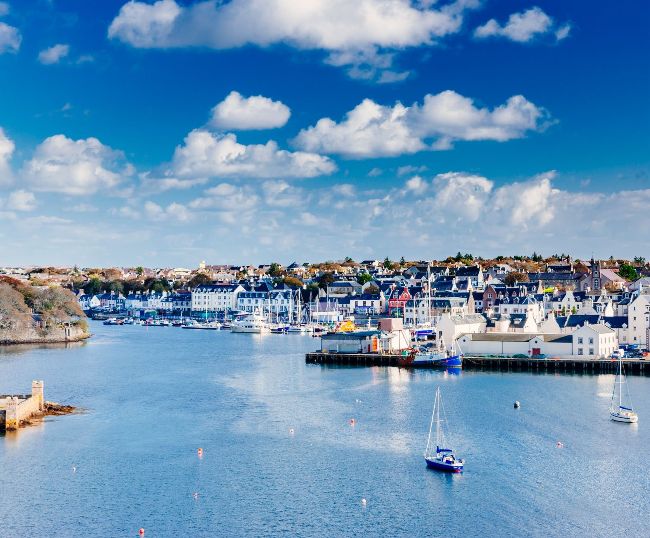Our presbyteries
Thomas Baldwin considers one of the Church of Scotland’s legacy presbyteries, the Presbytery of Lewis.
IN October, Tesco announced that its store in Stornoway, the capital of the Isle of Lewis, would begin opening on Sundays. Despite some local opposition, this was widely seen as a further relaxation of the strict Sabbatarianism that held sway on the island into the 21st century (Sunday ferry sailings did not begin until 2009), and evidence of the encroachment of secularism even in the most famously religious area of Scotland.
Against this backdrop the Presbytery of Lewis is ‘pressing on under the Lord’s help’, says its Clerk, the Rev Ben Johnstone. “We are facing the challenges that every congregation in the country has to face, but we’re confident in God’s presence, wisdom and vision, and in his strength,” he adds.
The Presbytery dates back to 1742, when the ‘Presbytery of the Long Island’, which covered the whole of the Outer Hebrides, was split into two: Lewis and Uist. Having declined to join Clèir Eilean Ì, the Presbytery that now covers the rest of the Highlands and Hebrides, Lewis is one of only two remaining ‘legacy’ presbyteries (with Glasgow) from the recent round of unions, and by far the smallest in Scotland.
Ben emphasises that relationships with the Highlands and Hebrides presbytery remain good. “There were very cordial discussions as we tried to listen to and understand each other so we could take an informed decision. There is no tension or difference. We wish them well and we are all part of the same mission.
“Whether this is going to be indefinitely, we can’t really tell. But we are pressing on in the present moment as Lewis Presbytery.”
That means managing with volunteers covering the presbytery’s statutory roles, instead of the paid staff the larger presbyteries are able to employ, but Ben says that they have the resources to fulfil those requirements so far. Mission Planning is still ongoing, and the presbytery is waiting to hear the report of a Review Group that visited in June.
Stornoway, home to around 8000 of Lewis’s 18,000 people, has three Church of Scotland congregations, each exercising very positive outreach initiatives and ministries. Martin’s Memorial Church is home to the Shed, which now employs 15 staff working in youth and schools, alcohol and drug recovery, and family support. Work began recently on the latest phase of the project, the Barn, which will refurbish the church hall into a new family centre.
St Columba’s Church celebrated its 230th anniversary in November 2024 with mission events and special services and continues a very fruitful ministry in and to different aspects of the life of Stornoway. The other town church, the High Church, offers, Ben says, ‘A very caring and positive ministry and outlook to its parish and its people’.
A further eight congregations are dotted round the island, offering, Ben says, ‘Faithful week by week preaching, pastoral and prayerful ministry.’
One of them is at Kinloch, 12 miles south-west of Stornoway, where the Rev Iain Murdo Campbell is minister. He too acknowledges that the Church in Lewis is facing the challenge of growing secularism, albeit he says ’we are probably about 20 to 30 years behind the rest of the country’.

Stornoway, Lewis
“Sunday used to be a day here when everything was shut, but that is changing,” he says. “We have a lot of people here who are unchurched and have no allegiance whatsoever to any church. Many people have no faith at all.”
Another change has been the decline of Gaelic worship, with most churches no longer offering services in the language on a regular basis. “Gaelic is not a huge part of my ministry,” says Iain, “And I think that would be true for most places today throughout the island. If we have a Gaelic service hardly anyone comes to it. Gaelic work seems to be more focused on the schools than it is on the church.”
As a further challenge, the presbytery was affected more than most by division in the Church over the General Assembly’s decisions on same-sex relationships since about 2010. Iain says: “I lost 50 per cent of my members and adherents, and most of my office bearers, so we have had to rebuild from that.”
Despite this, he says, most of the island’s Church of Scotland congregations are showing an increase in attendance from year to year. “We still have got a remnant here of folk who see church as being hugely important in the community. We hear a lot today about managing decline, but I think most of us are showing an upturn.
“So we haven’t given up, we’re still working hard to build on the foundations that have been laid.
“We made the decision to remain on our own for the time being, and so far so good, we’re just pressing on as normal.”
Despite all the changes and challenges, Ben says that Lewis remains a unique and special place for the church. “I think the pace of life generally, regardless of church life, is more gentle than the mainland. Clearly there’s still the challenge of godlessness and especially young people who need to be reached. But underlying everything, there’s a tangible sense of the Christian heritage that blessed Lewis and the island. There is a sense of God’s reality, and the need to respect Him and honour Him, and – Tesco or not – that is still something special about Lewis.”